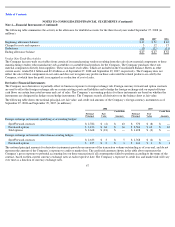Apple 2008 Annual Report Download - page 63
Download and view the complete annual report
Please find page 63 of the 2008 Apple annual report below. You can navigate through the pages in the report by either clicking on the pages listed below, or by using the keyword search tool below to find specific information within the annual report.
Table of Contents
NOTES TO CONSOLIDATED FINANCIAL STATEMENTS (Continued)
Note 1—Summary of Significant Accounting Policies (Continued)
SFAS No. 142, Goodwill and Other Intangible Assets requires that goodwill and intangible assets with indefinite useful lives should not be
amortized but rather be tested for impairment at least annually or sooner whenever events or changes in circumstances indicate that they may be
impaired. The Company performs its goodwill impairment tests on or about August 31 of each year. The Company did not recognize any
goodwill or intangible asset impairment charges in 2008, 2007, or 2006. The Company established reporting units based on its current reporting
structure. For purposes of testing goodwill for impairment, goodwill has been allocated to these reporting units to the extent it relates to each
reporting unit.
SFAS No. 142 also requires that intangible assets with definite lives be amortized over their estimated useful lives and reviewed for impairment
in accordance with SFAS No. 144. The Company is currently amortizing its acquired intangible assets with definite lives over periods ranging
from 1 to 10 years.
Foreign Currency Translation
The Company translates the assets and liabilities of its international non-U.S. dollar functional currency subsidiaries into U.S. dollars using
exchange rates in effect at the end of each period. Revenue and expenses for these subsidiaries are translated using rates that approximate those
in effect during the period. Gains and losses from these translations are credited or charged to foreign currency translation included in
accumulated other comprehensive income in shareholders’ equity. The Company’s foreign manufacturing subsidiaries and certain other
international subsidiaries that use the U.S. dollar as their functional currency remeasure monetary assets and liabilities at exchange rates in effect
at the end of each period, and inventories, property, and nonmonetary assets and liabilities at historical rates. Gains and losses from these
translations were insignificant and have been included in the Company’s results of operations.
Revenue Recognition
Net sales consist primarily of revenue from the sale of hardware, software, music products, digital content, peripherals, and service and support
contracts. For any product within these groups that either is software, or is considered software-related in accordance with the guidance in
Emerging Issues Task Force (“EITF”) No. 03-5, Applicability of AICPA Statement of Position 97-2 to Non-Software Deliverables in an
Arrangement Containing More
-Than-Incidental Software (e.g., Mac computers, iPod portable digital music players and iPhones), the Company
accounts for such products in accordance with the revenue recognition provisions of American Institute of Certified Public Accountants
(“AICPA”) Statement of Position (“SOP”) No. 97-2, Software Revenue Recognition , as amended. The Company applies Staff Accounting
Bulletin (“SAB”) No. 104, Revenue Recognition, for products that are not software or software-
related, such as digital content sold on the iTunes
Store and certain Mac, iPod and iPhone supplies and accessories.
The Company recognizes revenue when persuasive evidence of an arrangement exists, delivery has occurred, the sales price is fixed or
determinable, and collection is probable. Product is considered delivered to the customer once it has been shipped and title and risk of loss have
been transferred. For most of the Company’s product sales, these criteria are met at the time the product is shipped. For online sales to
individuals, for some sales to education customers in the U.S., and for certain other sales, the Company defers revenue until the customer
receives the product because the Company legally retains a portion of the risk of loss on these sales during transit. If at the outset of an
arrangement the Company determines the arrangement fee is not, or is presumed not to be, fixed or determinable, revenue is deferred and
subsequently recognized as amounts become due and payable and all other criteria for revenue recognition have been met.
Revenue from service and support contracts is deferred and recognized ratably over the service coverage periods. These contracts typically
include extended phone support, repair services, web-based support resources, diagnostic tools, and extend the service coverage offered under
the Company’s one-year limited warranty.
60
























